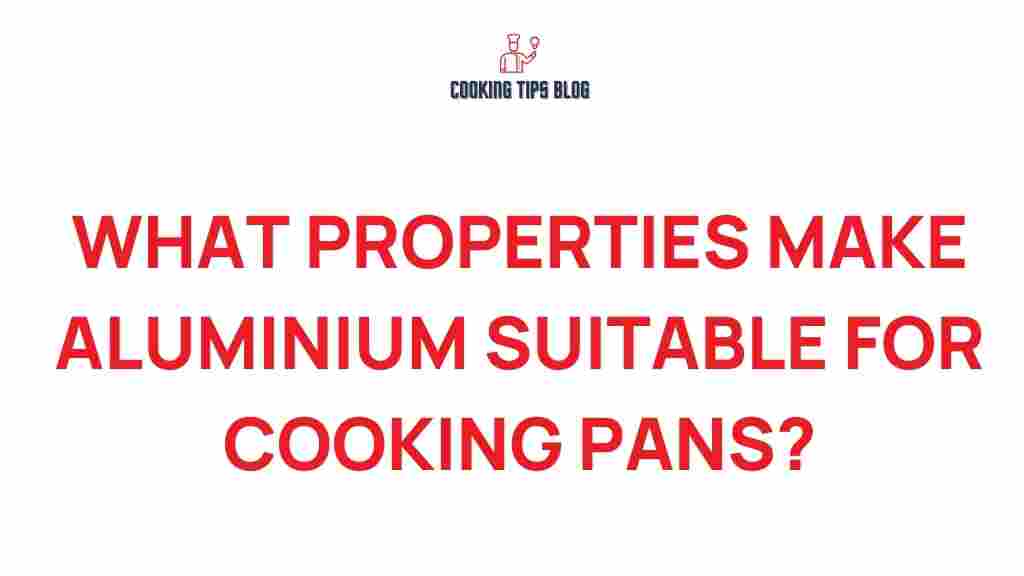Unveiling Aluminium: Why It’s the Go-To Choice for Cooking Pans
When it comes to cooking pans, the choice of material can significantly impact your culinary experience. Among various options available in the market, aluminium has emerged as a front-runner for both amateur cooks and professional chefs alike. This article will delve into the reasons why aluminium is the go-to choice for cooking pans, exploring its benefits, applications, and maintenance tips. By the end of this article, you’ll understand why this versatile metal is a staple in kitchens around the world.
The Advantages of Aluminium Cookware
Aluminium is widely recognized for its unique properties, making it a popular choice for cookware. Here are some of the key advantages:
- Excellent Heat Conductivity: Aluminium is a superb conductor of heat, which allows for even cooking and helps prevent hot spots that can burn food.
- Lightweight: Compared to other metals, aluminium is lightweight, making it easy to handle, especially when flipping or transferring food.
- Corrosion Resistance: Modern aluminium cookware often comes with a non-stick coating that not only enhances cooking performance but also protects against rust and corrosion.
- Affordability: Aluminium pans are generally more affordable than their stainless steel or cast iron counterparts, making them accessible for all budgets.
- Diverse Styles: From frying pans to saucepans, aluminium cookware is available in various styles and designs that cater to different cooking needs.
Types of Aluminium Cookware
There are several types of aluminium cookware that you can choose from, each with its unique features:
1. Anodized Aluminium Cookware
Anodized aluminium cookware undergoes an electrochemical process that makes it more durable and resistant to scratches. This type of cookware is often non-reactive, which means it won’t alter the taste of acidic foods.
2. Non-Stick Aluminium Cookware
Coated with a non-stick surface, this type of cookware allows for easy food release and simplified cleaning. It’s ideal for cooking delicate foods like eggs and pancakes.
3. Cast Aluminium Cookware
Cast aluminium pans are thicker and heavier, providing excellent heat retention. They are perfect for slow cooking and can withstand higher temperatures.
How to Care for Your Aluminium Cookware
To ensure longevity and optimal performance of your aluminium cookware, follow these simple care tips:
- Cleaning: Avoid using abrasive cleaners that can scratch the surface. Instead, use mild soap and a soft sponge.
- Storage: To prevent scratches, store your aluminium pans with a cloth or paper towel between them.
- Avoid High Heat: While aluminium can handle high temperatures, prolonged exposure can damage non-stick coatings. Use medium heat for best results.
Step-by-Step Process of Cooking with Aluminium Pans
Cooking with aluminium pans is straightforward. Here’s a step-by-step guide to help you maximize your cooking experience:
Step 1: Preheat Your Pan
Before adding any ingredients, preheat your aluminium pan on medium heat. This ensures even cooking and helps prevent sticking.
Step 2: Add Oil or Butter
Once the pan is heated, add a small amount of oil or butter. Allow it to heat until it shimmers before adding your food.
Step 3: Cook Your Ingredients
Add your ingredients to the pan, ensuring not to overcrowd it. This allows for proper heat circulation and browning.
Step 4: Adjust Heat as Necessary
If you notice the food cooking too quickly, reduce the heat to maintain control over the cooking process.
Step 5: Clean After Use
Once you’ve finished cooking, clean your aluminium pan promptly to prevent food residue from sticking. Use warm soapy water and a soft sponge for the best results.
Troubleshooting Common Issues with Aluminium Cookware
Even with proper care, you may encounter some issues while using aluminium cookware. Here are some common problems and solutions:
Problem: Food Sticking
Solution: Make sure to preheat your pan and use sufficient oil or butter. If you’re using non-stick aluminium, ensure that the coating is intact.
Problem: Discoloration
Solution: If your aluminium pans become discolored, try cleaning them with a mixture of vinegar and water. This can help restore their shine.
Problem: Scratches on Non-Stick Surface
Solution: Avoid using metal utensils on non-stick surfaces. Instead, use wooden or silicone utensils to prevent scratches.
Aluminium and Health Considerations
There has been some debate regarding the safety of using aluminium cookware. Here are some key points to consider:
- Reactivity with Foods: While aluminium is generally safe, it can react with acidic foods, causing a metallic taste. Anodized aluminium cookware minimizes this risk.
- Health Concerns: Studies have shown no direct link between aluminium cookware and health issues like Alzheimer’s disease, but it’s still advisable to use it in moderation.
Conclusion: The Ultimate Choice for Your Kitchen
In conclusion, aluminium cookware offers numerous benefits, including excellent heat conductivity, lightweight design, and affordability. With proper care and usage, it can serve as a reliable addition to your kitchen arsenal. Whether you’re sautéing vegetables or frying eggs, aluminium pans can enhance your cooking experience.
So, if you’re looking for versatile and efficient cookware, consider investing in aluminium pans. They are designed to meet a variety of cooking needs while providing durability and performance.
For more tips on cookware maintenance, feel free to explore our detailed guide. And for additional information on the benefits of different cooking materials, visit Cooking Materials 101.
This article is in the category Tools and created by Cookingtipsblog Team
